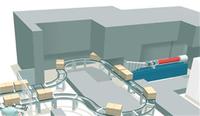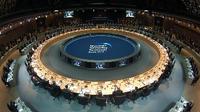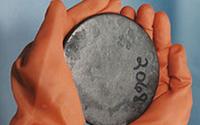-
E-beam technology to keep food supply safe

More than two million people a year, most of them children, die from food-borne or water-borne illness; more than one-third, or 1.3 billion tons, of the food produced for human consumption every year is wasted or lost because of spoilage; the UN nuclear weapons watch dog, the IAEA, says that irradiating food is a more effective solution for preventing death, illness, and food spoilage than techniques currently in use: heating, refrigerating, freezing, or chemical treatment
-
-
International collaborative effort to develop better radiation detection tool
In mid-February, the Flash Portal Project was launched with the aim of furthering the development and testing of a new technology to detect shielded nuclear materials
-
-
Traces of Japan’s nuclear reactor explosions found in New Hampshire
Dartmouth College researchers have found evidence of Japan’s Fukushima Daiichi nuclear reactor explosions in Hanover, New Hampshire
-
-
Test strip detects TNT and other explosives in water
Scientists developed a new explosives detector that can sense small amounts of TNT and other common explosives in liquids instantly with a sensitivity that rivals bomb-sniffing dogs, the current gold standard in protecting the public from terrorist bombs
-
-
Nuclear summit focuses on terrorist nukes

The Seoul nuclear summit focused on the risk of nuclear terrorism; there are two risks: first, fissile materials, which terrorists may use to construct a dirty bomb, is kept at thousands of medical, research, and industrial facilities around the world – often without sufficient security; second, constructing a Hiroshima-type bomb is not as difficult as we may think
-
-
A nuke blast in D.C. would not destroy city: report
A study finds that a 10-kiloton bomb detonated in Washington, D.C. would destroy many buildings and kill many people, but it would not completely destroy the city; says one expert: “If you are thinking about (a city) being wiped off the face of the earth, that’s not what happens”
-
-
U.S., three European countries, commit to HEU reductions

Leaders of Belgium, France, the Netherlands, and the United States said they were taking steps to minimize the use of Highly Enriched Uranium (HEU) for civilian purposes, where technically and economically feasible, in order to advance the goal of nuclear security
-
-
PositiveID’s M-BAND fits the bill for $3 billion BioWatch program
DHS’s $3.1 billion BioWatch program aims to place biosensors on top of utility poles and buildings in major American cities in order to detect bioterror attacks; PositiveID says its M-BAND solution is well positioned to be picked up by DHS for the program
-
-
Detection technology detects viruses, pathogens within 24 hours
New detection technology could enable food safety professionals, law enforcement, medical professionals, and others to detect within twenty-four hours any virus or bacteria that has been sequenced and included among the array’s probes
-
-
MRIGlobal awarded $9 million to evaluate detection gear
Kansas City company in a $9 million contract with the U.S. Army to test and evaluate equipment to identify chemical, biological, and radiological hazards in the field
-
-
Army scientists work to improve biothreat detection
A married couple, both scientists working at the U.S. Army’s Edgewood Chemical Biological Center, one of forty-five Biosafety Level 3 labs in the United States; they collaborate on improving the ability of soldiers and first responders to detect, identify, and protect against potentially lethal biological threat agents
-
-
New method for cleaning up nuclear waste
There are more than 436 nuclear power plants operating in thirty countries, and they create a lot of nuclear waste; one of the more toxic elements in that waste is radionuclide technetium (99Tc); approximately 305 metric tons of 99Tc were generated from nuclear reactors and weapons testing from 1943 through 2010
-
-
Radiation-laced Japanese seafood detected in South Korea

The effects of the Japanese nuclear crisis at the Fukushima Daichii atomic energy plant are continuing to ripple across the world
-
-
Breakthrough in next gen nuclear detectors

Researchers have long struggled to develop radiation detectors that can spot a nuclear device hidden away in a shielded case, but a recent breakthrough could change all that
-
-
Scientists develop a dirty bomb detection system
As part of a £3 million international project funded by the European Commission, scientists at the University of Liverpool are developing a mobile detection system for nuclear materials that could prevent the construction of atomic weapons and dirty bombs
-
More headlines
The long view
Keeping the Lights on with Nuclear Waste: Radiochemistry Transforms Nuclear Waste into Strategic Materials
How UNLV radiochemistry is pioneering the future of energy in the Southwest by salvaging strategic materials from nuclear dumps –and making it safe.
Model Predicts Long-Term Effects of Nuclear Waste on Underground Disposal Systems
The simulations matched results from an underground lab experiment in Switzerland, suggesting modeling could be used to validate the safety of nuclear disposal sites.
